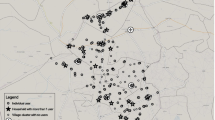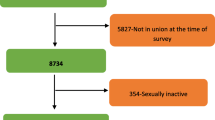Abstract
This paper blends quantitative with qualitative data in an investigation of community and contraceptive choice in Nang Rong, Thailand. Specifically, it develops an explanation of 1) method dominance within villages, coupled with 2) marked differences between villages in the popularity of particular methods. The quantitative analysis demonstrates the importance of village location and placement of family planning services for patterns of contraceptive choice. The qualitative data provide a complementary perspective, emphasizing the importance of social as well as physical space and giving particular attention to the structure of conversational networks.
Similar content being viewed by others
References
Arthur, W.B. 1988. “Competing Technologies: An Overview.” Pp. 590–607 in Technical Change and Economic Theory, edited by G. Dosi, C. Freeman, R. Nelson, G. Silverberg, and L. Soete. London: Pinter.
Bennett, A., C. Frisen, P. Kamnuansilpa, and J. McWilliam. 1990. “How Thailand’s Family Planning Program Reached Replacement Level Fertility: Lessons Learned.” Occasional Paper 4, Population Technical Assistance Project. Arlington, VA: Population Technical Assistance Project.
Brewster, K.L. 1994. “Neighborhood Context and the Transition to Sexual Activity among Young Black Women.” Demography 31:603–14.
Bumpass, L.L. 1987. “The Risk of an Unwanted Birth: The Changing Context of Contraceptive Sterilization in the US.” Population Studies 41:347–64.
Carnic, C. 1986. “The Matter of Habit.” American Journal of Sociology 91:1039–87.
Casterline, J.B., ed. 1985. The Collection and Analysis of Community Data. Voorburg, The Netherlands: International Statistical Institute.
Chamratrithirong, A. and P. Kamnuansilpa. 1984. “How Family Planning Availability Affects Contraceptive Use: The Case of Thailand.” Pp. 219–35 in Survey Analysis for the Guidance of Family Planning Programs, edited by J.A. Ross and R. McNamara. Liege: Ordina Editions.
Chayovan, N., A.I. Hermalin, and J. Knodel. 1984. “Measuring Accessibility to Family Planning in Rural Thailand.” Studies in Family Planning 15:201–11.
Cleland, J. and C. Wilson. 1987. “Demand Theories of the Fertility Transition: An Iconoclastic View.” Population Studies 41:5–30.
Cochrane, S. and D.K. Guilkey. 1991a. “The Effect of Access on Contraceptive Use and Fertility in Colombia.” Presented at the Demographic and Health Survey World Conference, Washington, DC.
Cochrane, S. and D.K. Guilkey. 1991b. “The Effects of Access on Contraceptive Use in Tunisia: Tracing Through the Effects of Social Services on Contraceptive Use.” Mimeographed document, World Bank.
Entwisle, B., J.B. Casterline, and H.A.-A. Sayed. 1989. “Villages as Contexts for Contraceptive Behavior in Rural Egypt.” American Sociological Review 54: 1019–34.
Entwisle, B., A.I. Hermalin, P. Kamnuansilpa, and A. Chamratrithirong. 1984. “A Multilevel Model of Family Planning Availability and Contraceptive Use in Rural Thailand.” Demography 21:559–74.
Freedman, R.C. 1974. “Community-Level Data in Fertility Surveys.” WFS Occasional Papers 8. Voorburg, The Netherlands: International Statistical Institute.
Guilkey, D.K. 1992. Community Effects in Demographic and Health Survey Data. Working Paper, IRD/Macro, Columbia, MD.
Kamnuansilpa, P. and A. Chamratrithirong. 1985. Contraceptive Use and Fertility in Thailand: Results from the Contraceptive Prevalence Survey. Bangkok: National Family Planning Program, Ministry of Public Health.
Krongkaew, M., A. Chamratrithirong, and V. Woromotri. 1983. A Study of Low-Income Households in the Northeastern Region of Thailand. Salaya: Institution of Population and Social Research, Mahidol University.
Lee, N.H. 1969. The Search for an Abortionist. Chicago: University of Chicago Press.
Maddala, G.S. 1983. Limited-Dependent and Qualitative Variables in Economics. Cambridge, UK: Cambridge University Press.
Mason, W.M. and V.T. Palan. 1978. “Community-Level Variables and Their Effects on Reproductive Behavior in Malaysia.” Presented at the Conference on Comparative Fertility Transition in Asia, Tokyo.
Phillips, J.F. and E. Zimmerman. 1993. “Assessing the Demographic Role of Program Effect with DHS Data from Six Developing Countries.” Presented at the Annual Meetings of the Population Association of America, Cincinnati.
Rindfuss, R.R. and T.F. Liao. 1988. “Medical and Contraceptive Reasons for Sterilization in the United States.” Studies in Family Planning 19:370–80.
Rogers, E.M. 1979. “Network Analysis of the Diffusion of Innovations.” Pp. 137–64 in Perspectives on Social Network Research, Edited by P.W. Holland and S. Leinhardt. Stanford: Center for Advanced Study in the Behavioral Sciences.
Rosero-Bixby, L. and J.B. Casterline. 1993. “Modeling Diffusion Effects in the Fertility Transition.” Population Studies 38:147–67.
Tsui, A.O., D.P. Hogan, J.D. Teachman, and C. Welti-Chanes. 1981. “Community Availability of Contraceptives and Family Limitation.” Demography 18:615–25.
Watkins, S.C. 1991. “Markets, States, Nations, and Bedrooms in Western Europe, 1870–1960.” Pp. 263–79 in Macro-Micro Linkages in Sociology, edited by J. Huber. Newbury Park, CA: Sage.
Yodumnern-Attig, B. 1992. “Thai Family Structure and Organization: Changing Roles and Duties in Historical Perspective.” Pp. 8–24 in Changing Roles and Status of Women in Thailand: A Documentary Assessment, edited by B. Yoddumnern-Attig, K. Richter, A. Soonthorndhada, C. Sethaput, and A. Pramualratana. Bangkok: Institute for Population and Social Research.
Author information
Authors and Affiliations
Corresponding author
Additional information
This research was partially supported by Grant R01 HD25482 from the National Institute of Child Health and Human Development. It also benefited from centers grants to the Carolina Population Center from the Mellon Foundation and the National Institute of Child Health and Human Development, and from support provided by the Center for Advanced Study in the Behavioral Sciences. We would like to thank Peter Bearman, Karin Brewster, Philip Guest, Philip Morgan, Joseph Potter, Susan Watkins, and two anonymous reviewers for helpful comments on an earlier draft of this paper, and Erika Stone, Phil Bardsley, and Alan Snavely for expert programming assistance.
Rights and permissions
About this article
Cite this article
Entwisle, B., Rindfuss, R.R., Guilkey, D.K. et al. Community and contraceptive choice in rural Thailand: A case study of Nang Rong. Demography 33, 1–11 (1996). https://doi.org/10.2307/2061709
Issue Date:
DOI: https://doi.org/10.2307/2061709




